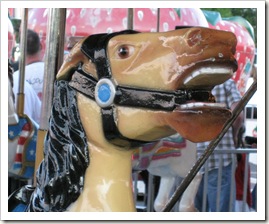Canada Day 2009: rubber ducks, ferris wheels, and tips on taking pictures of fireworks
 I got together with friends that I’ve known most of my life – one of them since I was kindergarten-aged. We had a BBQ at one of their houses and then headed out to Kanata and took part in the festivities there. As in past years, there was a carnival with rides for the kids, so we spent some time there – I even took one of the munchkins on the ferris wheel at her request, which was a lot of fun for both of us. To say she enjoyed it would be an understatement. There was also a booth that had
I got together with friends that I’ve known most of my life – one of them since I was kindergarten-aged. We had a BBQ at one of their houses and then headed out to Kanata and took part in the festivities there. As in past years, there was a carnival with rides for the kids, so we spent some time there – I even took one of the munchkins on the ferris wheel at her request, which was a lot of fun for both of us. To say she enjoyed it would be an understatement. There was also a booth that had  a pool full of rubber ducks swirling around and a merry go round, both of which presented great photo opportunities.
a pool full of rubber ducks swirling around and a merry go round, both of which presented great photo opportunities.
As it got darker we made our way to a higher vantage point to watch the fireworks. I had my Canon SD850IS with me, so I took a lot of long-exposure pictures. I didn’t have a tripod, so I had to brace the camera or hold it steady.
A couple of people have asked me how to take pictures of fireworks recently, so I thought I’d share some of the tricks I use. And at the end you can see my results. 🙂
While it’s true that, in general, you can take a good picture with virtually any camera from a low-resolution camera phone to a 12 megapixel digital SLR, the type of camera you use to take pictures of fireworks will have more of an impact on the results. Choosing a camera that allows you to have full control over all of the settings (shutter speed, aperture and “film speed”) will make it easier to get that perfect shot. A digital single-lens reflex (DSLR) will give you this level of control, as can many “viewfinder” point-and-shoot cameras.
Personally, I have two cameras: a Canon Digital Rebel XT DSLR with an optically-stabilized lens, and a Canon SD850IS, which is a point-and-shoot. Where I’m going and how much stuff I want to carry with me is often the deciding factor as to which I’ll bring with me. Often, I’ll carry just the SD850 since it has a little pouch with a belt clip on it.
First: Regardless of how much you camera may complain, turn off the flash. If you don’t, you’ll end up with pictures that have things in the foreground like trees, buildings and people that are illuminated, while everything else is underexposed. And if there’s any dust in the air, you run the risk of have bright speckles caused by backscatter from the flash.
Second: The next setting to adjust is the equivalent film speed. Also referred to as “ASA” or “ISO”, the equivalent film speed setting determines how the camera sensor responds to light. The higher the setting, the more sensitive the sensor is to light. (Higher ISO settings also allow you to use a faster shutter speed, which can be very useful when shooting fast-moving subjects, such as sporting events.) For fireworks, you want to capture as much light as possible, so choose the highest number possible. In the case of my SD850, this is 1600.
(Depending on your camera, you may have to change to “manual” mode as the “automatic” mode on some cameras won’t give you enough control.)
If you can, turn off auto focus and manually focus on something that is roughly the same distance away as where the fireworks will be. If you’re far away, setting the focus to infinity or just short of infinity should do the trick. Point-and-shoot cameras don’t usually allow you to do this, but don’t worry. I’ve used my SD850 with great success and it doesn’t let me turn off the auto focus.
One other thing that can make a huge difference is the use of a tripod or beanbag to steady your camera. Exposures could be as long as several seconds and any movement will result in “squiggles” – probably not what you want.
This combination of settings should give you a good starting point. While your camera may allow you to control the exposure length and aperture setting, you can probably start by leaving these on “auto” for the moment and take some test shots when the fireworks start – I’ve had a lot of success with this strategy. By increasing the length of the exposure, you’ll increase the length of the trails of the fireworks burst. If you make it too long, however, you’ll start to see smudges as the glowing particles drift while they fade.
Timing is key. If you’re trying to take a photo showing the whole burst, you need to anticipate things and click the shutter just before the fireworks bomb pops. This is something that will come with practice. Good luck!
Here’s a selection of photos that I shot using my SD850. I’m quite happy with the results and Ken has some good shots on his blog, too.




 AKA Keeper of Maps, I'm a geocacher who lives in Ottawa, Canada.
AKA Keeper of Maps, I'm a geocacher who lives in Ottawa, Canada.
